ABL2
| ABL2 | |||||||||||||||||||||||||||||||||||||||||||||||||||
|---|---|---|---|---|---|---|---|---|---|---|---|---|---|---|---|---|---|---|---|---|---|---|---|---|---|---|---|---|---|---|---|---|---|---|---|---|---|---|---|---|---|---|---|---|---|---|---|---|---|---|---|
 | |||||||||||||||||||||||||||||||||||||||||||||||||||
| |||||||||||||||||||||||||||||||||||||||||||||||||||
| Identifiers | |||||||||||||||||||||||||||||||||||||||||||||||||||
| Aliases | ABL2, ABLL, ARG, ABL proto-oncogene 2, non-receptor tyrosine kinase | ||||||||||||||||||||||||||||||||||||||||||||||||||
| External IDs | OMIM: 164690; MGI: 87860; HomoloGene: 5278; GeneCards: ABL2; OMA:ABL2 - orthologs | ||||||||||||||||||||||||||||||||||||||||||||||||||
| |||||||||||||||||||||||||||||||||||||||||||||||||||
| |||||||||||||||||||||||||||||||||||||||||||||||||||
| |||||||||||||||||||||||||||||||||||||||||||||||||||
| |||||||||||||||||||||||||||||||||||||||||||||||||||
| |||||||||||||||||||||||||||||||||||||||||||||||||||
| Wikidata | |||||||||||||||||||||||||||||||||||||||||||||||||||
| |||||||||||||||||||||||||||||||||||||||||||||||||||
Tyrosine-protein kinase ABL2 also known as Abelson-related gene (Arg) is an enzyme that in humans is encoded by the ABL2 gene.[5][6]
Function
ABL2 is a cytoplasmic tyrosine kinase which is closely related to but distinct from ABL1. The similarity of the proteins includes the tyrosine kinase domains and extends amino-terminal to include the SH2 and SH3 domains. ABL2 is expressed in both normal and tumor cells. The expression of ABL2 gene is higher in KRAS mutant non-small cell lung cancer.[7] The ABL2 gene product is expressed as two variants bearing different amino termini, both approximately 12-kb in length.[6]
Interactions
ABL2 has been shown to interact with three proteins: Abl gene,[8] catalase,[9] and SORBS2.[10] The protein Abl gene is also known as abelson murine leukemia viral oncogene homolog 1 and is a protein that is encoded by the human ABL1 gene.[11] Catalase is a common enzyme that catalyzes the decomposition of hydrogen peroxide to water and oxygen.[12] SORBS2 is also known as Sorbin and SH3 domain-containing protein 2 and is a protein encoded by the SORBS2 gene in humans.[6][10][13]
References
- ^ a b c GRCh38: Ensembl release 89: ENSG00000143322 – Ensembl, May 2017
- ^ a b c GRCm38: Ensembl release 89: ENSMUSG00000026596 – Ensembl, May 2017
- ^ "Human PubMed Reference:". National Center for Biotechnology Information, U.S. National Library of Medicine.
- ^ "Mouse PubMed Reference:". National Center for Biotechnology Information, U.S. National Library of Medicine.
- ^ Kruh GD, King CR, Kraus MH, Popescu NC, Amsbaugh SC, McBride WO, Aaronson SA (Jan 1987). "A novel human gene closely related to the abl proto-oncogene". Science. 234 (4783): 1545–8. doi:10.1126/science.3787260. PMID 3787260.
- ^ a b c "Entrez Gene: ABL2 v-abl Abelson murine leukemia viral oncogene homolog 2 (arg, Abelson-related gene)".
- ^ Nagy Á, Pongor LS, Szabó A, Santarpia M, Győrffy B (2017-02-15). "KRAS driven expression signature has prognostic power superior to mutation status in non-small cell lung cancer". International Journal of Cancer. 140 (4): 930–937. doi:10.1002/ijc.30509. ISSN 1097-0215. PMC 5299512. PMID 27859136.
- ^ Cao C, Leng Y, Li C, Kufe D (April 2003). "Functional interaction between the c-Abl and Arg protein-tyrosine kinases in the oxidative stress response". J. Biol. Chem. 278 (15): 12961–7. doi:10.1074/jbc.M300058200. PMID 12569093.
- ^ Cao C, Leng Y, Kufe D (August 2003). "Catalase activity is regulated by c-Abl and Arg in the oxidative stress response". J. Biol. Chem. 278 (32): 29667–75. doi:10.1074/jbc.M301292200. PMID 12777400.
- ^ a b Wang B, Golemis EA, Kruh GD (July 1997). "ArgBP2, a multiple Src homology 3 domain-containing, Arg/Abl-interacting protein, is phosphorylated in v-Abl-transformed cells and localized in stress fibers and cardiocyte Z-disks". J. Biol. Chem. 272 (28): 17542–50. doi:10.1074/jbc.272.28.17542. hdl:20.500.12613/9174. PMID 9211900.
- ^ Szczylik C, Skorski T, Nicolaides NC, Manzella L, Malaguarnera L, Venturelli D, Gewirtz AM, Calabretta B (August 1991). "Selective inhibition of leukemia cell proliferation by BCR-ABL antisense oligodeoxynucleotides". Science. 253 (5019): 562–5. Bibcode:1991Sci...253..562S. doi:10.1126/science.1857987. PMID 1857987.
- ^ Chelikani P, Fita I, Loewen PC (January 2004). "Diversity of structures and properties among catalases". Cell. Mol. Life Sci. 61 (2): 192–208. doi:10.1007/s00018-003-3206-5. hdl:10261/111097. PMID 14745498. S2CID 4411482.
- ^ Nagase T, Ishikawa K, Suyama M, Kikuno R, Miyajima N, Tanaka A, Kotani H, Nomura N, Ohara O (Apr 1999). "Prediction of the coding sequences of unidentified human genes. XI. The complete sequences of 100 new cDNA clones from brain which code for large proteins in vitro". DNA Res. 5 (5): 277–86. doi:10.1093/dnares/5.5.277. PMID 9872452.
Further reading
- Bradley WD, Koleske AJ (2009). "Regulation of cell migration and morphogenesis by Abl-family kinases: emerging mechanisms and physiological contexts". J Cell Sci. 122 (19): 3441–54. doi:10.1242/jcs.039859. PMC 2746129. PMID 19759284.
- Pendergast AM (2003). "The Abl family kinases: mechanisms of regulation and signaling". Adv. Cancer Res. Advances in Cancer Research. 85: 51–100. doi:10.1016/S0065-230X(02)85003-5. ISBN 0120066858. PMID 12374288.
- Muller AJ, Pendergast AM, Havlik MH, et al. (1992). "A limited set of SH2 domains binds BCR through a high-affinity phosphotyrosine-independent interaction". Mol. Cell. Biol. 12 (11): 5087–93. doi:10.1128/mcb.12.11.5087. PMC 360442. PMID 1383690.
- Kruh GD, Perego R, Miki T, Aaronson SA (1990). "The complete coding sequence of arg defines the Abelson subfamily of cytoplasmic tyrosine kinases". Proc. Natl. Acad. Sci. U.S.A. 87 (15): 5802–6. Bibcode:1990PNAS...87.5802K. doi:10.1073/pnas.87.15.5802. PMC 54416. PMID 2198571.
- Kruh GD, King CR, Kraus MH, et al. (1987). "A novel human gene closely related to the abl proto-oncogene". Science. 234 (4783): 1545–8. doi:10.1126/science.3787260. PMID 3787260.
- Maruyama K, Sugano S (1994). "Oligo-capping: a simple method to replace the cap structure of eukaryotic mRNAs with oligoribonucleotides". Gene. 138 (1–2): 171–4. doi:10.1016/0378-1119(94)90802-8. PMID 8125298.
- Wang B, Kruh GD (1996). "Subcellular localization of the Arg protein tyrosine kinase". Oncogene. 13 (1): 193–7. PMID 8700546.
- Wang B, Mysliwiec T, Feller SM, et al. (1996). "Proline-rich sequences mediate the interaction of the Arg protein tyrosine kinase with Crk". Oncogene. 13 (7): 1379–85. PMID 8875975.
- Wang B, Golemis EA, Kruh GD (1997). "ArgBP2, a multiple Src homology 3 domain-containing, Arg/Abl-interacting protein, is phosphorylated in v-Abl-transformed cells and localized in stress fibers and cardiocyte Z-disks". J. Biol. Chem. 272 (28): 17542–50. doi:10.1074/jbc.272.28.17542. hdl:20.500.12613/9174. PMID 9211900.
- Suzuki Y, Yoshitomo-Nakagawa K, Maruyama K, et al. (1997). "Construction and characterization of a full length-enriched and a 5'-end-enriched cDNA library". Gene. 200 (1–2): 149–56. doi:10.1016/S0378-1119(97)00411-3. PMID 9373149.
- Koval AP, Blakesley VA, Roberts CT, et al. (1998). "Interaction in vitro of the product of the c-Crk-II proto-oncogene with the insulin-like growth factor I receptor". Biochem. J. 330 (2): 923–32. doi:10.1042/bj3300923. PMC 1219226. PMID 9480911.
- Hashimoto Y, Katayama H, Kiyokawa E, et al. (1998). "Phosphorylation of CrkII adaptor protein at tyrosine 221 by epidermal growth factor receptor". J. Biol. Chem. 273 (27): 17186–91. doi:10.1074/jbc.273.27.17186. PMID 9642287.
- Danial NN, Losman JA, Lu T, et al. (1998). "Direct interaction of Jak1 and v-Abl is required for v-Abl-induced activation of STATs and proliferation". Mol. Cell. Biol. 18 (11): 6795–804. doi:10.1128/mcb.18.11.6795. PMC 109263. PMID 9774693.
- Cao C, Ren X, Kharbanda S, et al. (2001). "The ARG tyrosine kinase interacts with Siva-1 in the apoptotic response to oxidative stress". J. Biol. Chem. 276 (15): 11465–8. doi:10.1074/jbc.C100050200. PMC 3476318. PMID 11278261.
- Yu HH, Zisch AH, Dodelet VC, Pasquale EB (2001). "Multiple signaling interactions of Abl and Arg kinases with the EphB2 receptor". Oncogene. 20 (30): 3995–4006. doi:10.1038/sj.onc.1204524. PMID 11494128.
- Endo A, Nagashima K, Kurose H, et al. (2002). "Sphingosine 1-phosphate induces membrane ruffling and increases motility of human umbilical vein endothelial cells via vascular endothelial growth factor receptor and CrkII". J. Biol. Chem. 277 (26): 23747–54. doi:10.1074/jbc.M111794200. PMID 11956190.
- Abassi YA, Vuori K (2002). "Tyrosine 221 in Crk regulates adhesion-dependent membrane localization of Crk and Rac and activation of Rac signaling". EMBO J. 21 (17): 4571–82. doi:10.1093/emboj/cdf446. PMC 126186. PMID 12198159.
- Bianchi C, Muradore I, Corizzato M, et al. (2002). "The expression of the non-receptor tyrosine kinases Arg and c-abl is differently modulated in B lymphoid cells at different stages of differentiation". FEBS Lett. 527 (1–3): 216–222. doi:10.1016/S0014-5793(02)03233-7. PMID 12220663.
- Strausberg RL, Feingold EA, Grouse LH, et al. (2003). "Generation and initial analysis of more than 15,000 full-length human and mouse cDNA sequences". Proc. Natl. Acad. Sci. U.S.A. 99 (26): 16899–903. Bibcode:2002PNAS...9916899M. doi:10.1073/pnas.242603899. PMC 139241. PMID 12477932.
- Salomon AR, Ficarro SB, Brill LM, et al. (2003). "Profiling of tyrosine phosphorylation pathways in human cells using mass spectrometry". Proc. Natl. Acad. Sci. U.S.A. 100 (2): 443–8. Bibcode:2003PNAS..100..443S. doi:10.1073/pnas.2436191100. PMC 141014. PMID 12522270.
External links
- Genes,+abl at the U.S. National Library of Medicine Medical Subject Headings (MeSH)
- Abelson+Leukemia+Virus at the U.S. National Library of Medicine Medical Subject Headings (MeSH)
- ABL2 Info with links in the Cell Migration Gateway
- Human ABL2 genome location and ABL2 gene details page in the UCSC Genome Browser.
- v
- t
- e
-
 1ab2: THREE-DIMENSIONAL SOLUTION STRUCTURE OF THE SRC HOMOLOGY 2 DOMAIN OF C-ABL
1ab2: THREE-DIMENSIONAL SOLUTION STRUCTURE OF THE SRC HOMOLOGY 2 DOMAIN OF C-ABL -
 1abo: CRYSTAL STRUCTURE OF THE COMPLEX OF THE ABL TYROSINE KINASE SH3 DOMAIN WITH 3BP-1 SYNTHETIC PEPTIDE
1abo: CRYSTAL STRUCTURE OF THE COMPLEX OF THE ABL TYROSINE KINASE SH3 DOMAIN WITH 3BP-1 SYNTHETIC PEPTIDE -
 1abq: CRYSTAL STRUCTURE OF THE UNLIGANDED ABL TYROSINE KINASE SH3 DOMAIN
1abq: CRYSTAL STRUCTURE OF THE UNLIGANDED ABL TYROSINE KINASE SH3 DOMAIN -
 1bbz: CRYSTAL STRUCTURE OF THE ABL-SH3 DOMAIN COMPLEXED WITH A DESIGNED HIGH-AFFINITY PEPTIDE LIGAND: IMPLICATIONS FOR SH3-LIGAND INTERACTIONS
1bbz: CRYSTAL STRUCTURE OF THE ABL-SH3 DOMAIN COMPLEXED WITH A DESIGNED HIGH-AFFINITY PEPTIDE LIGAND: IMPLICATIONS FOR SH3-LIGAND INTERACTIONS -
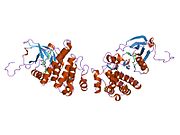 1fpu: CRYSTAL STRUCTURE OF ABL KINASE DOMAIN IN COMPLEX WITH A SMALL MOLECULE INHIBITOR
1fpu: CRYSTAL STRUCTURE OF ABL KINASE DOMAIN IN COMPLEX WITH A SMALL MOLECULE INHIBITOR -
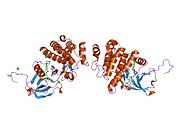 1iep: CRYSTAL STRUCTURE OF THE C-ABL KINASE DOMAIN IN COMPLEX WITH STI-571.
1iep: CRYSTAL STRUCTURE OF THE C-ABL KINASE DOMAIN IN COMPLEX WITH STI-571. -
 1ju5: Ternary complex of an Crk SH2 domain, Crk-derived phophopeptide, and Abl SH3 domain by NMR spectroscopy
1ju5: Ternary complex of an Crk SH2 domain, Crk-derived phophopeptide, and Abl SH3 domain by NMR spectroscopy -
 1m52: Crystal Structure of the c-Abl Kinase domain in complex with PD173955
1m52: Crystal Structure of the c-Abl Kinase domain in complex with PD173955 -
 1opj: Structural basis for the auto-inhibition of c-Abl tyrosine kinase
1opj: Structural basis for the auto-inhibition of c-Abl tyrosine kinase -
 2e2b: Crystal structure of the c-Abl kinase domain in complex with INNO-406
2e2b: Crystal structure of the c-Abl kinase domain in complex with INNO-406 -
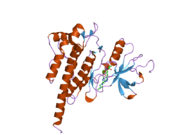 2f4j: Structure of the Kinase Domain of an Imatinib-Resistant Abl Mutant in Complex with the Aurora Kinase Inhibitor VX-680
2f4j: Structure of the Kinase Domain of an Imatinib-Resistant Abl Mutant in Complex with the Aurora Kinase Inhibitor VX-680 -
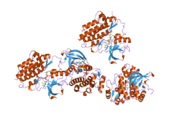 2g1t: A Src-like Inactive Conformation in the Abl Tyrosine Kinase Domain
2g1t: A Src-like Inactive Conformation in the Abl Tyrosine Kinase Domain -
 2g2f: A Src-like Inactive Conformation in the Abl Tyrosine Kinase Domain
2g2f: A Src-like Inactive Conformation in the Abl Tyrosine Kinase Domain -
 2g2h: A Src-like Inactive Conformation in the Abl Tyrosine Kinase Domain
2g2h: A Src-like Inactive Conformation in the Abl Tyrosine Kinase Domain -
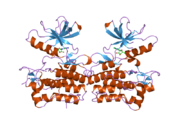 2g2i: A Src-like Inactive Conformation in the Abl Tyrosine Kinase Domain
2g2i: A Src-like Inactive Conformation in the Abl Tyrosine Kinase Domain -
 2gqg: X-ray Crystal Structure of Dasatinib (BMS-354825) Bound to Activated ABL Kinase Domain
2gqg: X-ray Crystal Structure of Dasatinib (BMS-354825) Bound to Activated ABL Kinase Domain -
 2hiw: Crystal Structure of Inactive Conformation Abl Kinase Catalytic Domain Complexed with Type II Inhibitor
2hiw: Crystal Structure of Inactive Conformation Abl Kinase Catalytic Domain Complexed with Type II Inhibitor -
 2hyy: Human Abl kinase domain in complex with imatinib (STI571, Glivec)
2hyy: Human Abl kinase domain in complex with imatinib (STI571, Glivec) -
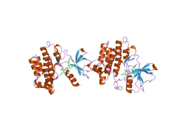 2hz0: Abl kinase domain in complex with NVP-AEG082
2hz0: Abl kinase domain in complex with NVP-AEG082 -
 2hz4: Abl kinase domain unligated and in complex with tetrahydrostaurosporine
2hz4: Abl kinase domain unligated and in complex with tetrahydrostaurosporine -
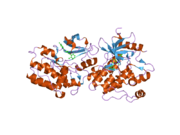 2hzi: Abl kinase domain in complex with PD180970
2hzi: Abl kinase domain in complex with PD180970 -
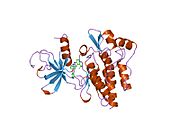 2hzn: Abl kinase domain in complex with NVP-AFG210
2hzn: Abl kinase domain in complex with NVP-AFG210









































